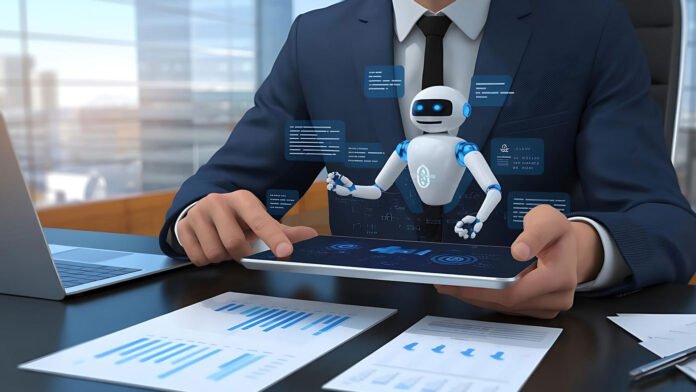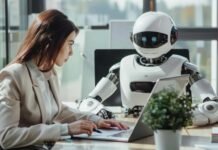Hiring the right workforce and retaining them is like sourcing the raw material for your abode. While ensuring its quality, there are many other factors that need to be considered, but if you’re given a quarter to build a two-story house, is there any chance you’d pick the qualitative method? Of course not. Usually, in such a case, you’ll choose the fastest and least concerning process.
But if you get an extended budget on the resources (AI in this context) to assist, you should be making three houses each quarter, right? Not exactly. There’s more to AI in the workforce.
AI-Powered Hiring Models for Smarter Workforce Management
1. How has AI changed the workforce?
2. Emerging AI practices in workforce management
3. Is AI making workforce management inhumane?
3.1 Fear around AI
3.2 Crème de la crème bias
4. Effective strategies for incorporating AI in workforce management
5. Conclusion
1. How has AI changed the workforce?
With its very own positives and negatives, AI has driven the workforce to the brink of a revolution as significant as the industrial revolution, where the parameters of work and value propositions of both parties will be changed forever. Today, we see labor-intensive tasks being automated, thanks to NLPs.
Automation has been aiding individuals by reducing tedious tasks and giving them the opportunity to do some more brainwork. But at the same time, we can also see displacement in jobs and demand for higher-skilled individuals. Technical prowess is of negligible importance these days. And hence, the threat of being kicked out of the race stands. Because if you are not using AI, you might as well sloth your way out of it. And this is just the beginning.
2. Emerging AI practices in workforce management
Although a big majority of 92% or more employees are in favor of workforce automation, only 47% of the workforce, according to a McKinsey report, is mature enough to enact the same. Still, the situation might sound a bit scary, but there are also companies that are doing it in an amazing way. Below are some of the most common practices that are proving to be great for the management of the workforce.
Smart Scheduling and Forecasting: AI analyzes seasonal patterns, shopper behavior, weather, local events, etc., and applies it to a pool of data for the accurate forecasting of labor requirements and for optimizing labor schedules, which in turn leads to higher labor productivity and the reduction of inefficiencies.
Adaptive Scheduling in Real Time: The real-time workforce shifts changing brought about by AI technology are dynamic in nature and respond to real-time events like employee absence or demand shifting, thus allowing the company to be much more operationally responsive.
Automation of Administrative Processes: With the help of AI, routine HR tasks such as payroll, compliance tracking, shift allocation, and performance monitoring are becoming increasingly automated, which in turn frees up managers to focus on the more strategic aspects of their work.
Advanced Predictive Analytics: Through predictive analytics, AI detects skills shortages in the workforce, forecasts labor demand, finds out the areas where retention is at risk, and recommends personalized training and development programs.
Generative AI for Decision Support: State-of-the-art generative AI models provide natural language descriptions of complex workforce data trends, which in turn lead to faster insight-based decision-making.
AI-Powered Virtual Assistants: Communication is simplified by the use of chatbots and virtual assistants that can autonomously handle employee questions, shift swaps, and HR support, thus contributing to a better and more engaged employee experience.
3. Is AI making workforce management inhumane?
The origin of AI came with its capability to surpass the creator itself. From the very beginning, the intention of AI’s emergence is to achieve maximum technological potential. But what about the creator? Major challenges brought by AI involve the displacement of jobs and uncertainty around life purposes thereafter. What are we working for if work is getting done at the end of the day?
3.1 Fear around AI
According to Goldman Sachs, the US is subject to a 6-7% displacement rate when it comes to jobs. Onboarding of AI will not be long enough to find a replacement for the displaced jobs. But yet again, this displacement is predicted to be temporary. This in return does create chaos in the management teams.
How to decide who goes first and how to ensure the best use of resources while maintaining peace in the workforce. Retention? Transition? Layoffs? What’s the answer?
3.2 Crème de la crème bias
With that said, even hiring comes with its own challenges. We can’t deny the monumental role AI is playing by filtering applications, scoring them, facilitating one-way interviews, etc. But at the same time, since the labor-intensive tasks are catered to in every field, the next best move is to hire highly skilled individuals.
The crème de la crème of the lot will always get preference. This will further create a pattern where highly skilled individuals will get roped like cinnamon on Silk Street. And since no other individuals are fit, the average is taken care of by AI; there won’t be enough highly skilled individuals for all organizations.
4. Effective strategies for incorporating AI in workforce management
Unsupervised AI could lead to the continued existence of biases against the groups of people that have been historically marginalized. When automating the whole process of hiring too much, it may even make the candidate experience impersonality, thereby negatively affecting the employer’s brand and the candidate’s satisfaction. To achieve both speed and fairness, HR leaders ought to set up human-in-the-loop checks, keep the AI function transparent, and adopt ethical AI practices.
The technology most smartly used in AI recruitment is, to a large extent, constructed around three models, namely natural language processing (NLP) for skill extraction and resume analysis, predictive analytics for candidate ranking according to past fit and success, and powerful computer vision models that measure video interviews by inferring both verbal and non-verbal behavior. Research indicates that such methods can cut the time taken to hire by half, to around 40%, while at the same time increasing the matching of candidates to positions and enabling recruiters to devote more time to high-value-added activities such as making talent maps and nurturing passive talent.
A usable AI implementation roadmap includes surveying the current HR maturity of implementation and issues, piloting some processes such as screening resumes or engagement surveys, training HR teams on AI L and ethics, and plugging AI modules into live ATS and HRIS systems. Continuous monitoring using key hiring metrics and quarterly bias audits will ensure that AI remains effective and free of bias over the long run.
5. Conclusion
In the words of Nobel laureate and Godfather of AI Geoffrey Hinton, “If the benefits of the increased productivity (of AI) can be shared equally, it will be a wonderful advance for all humanity.”
Processes can be sped up and automated in a jiffy with AI. Anything and everything can be taught as long as it is predictable and has a pattern, but it won’t always be the case. The workforce is unpredictable. Human interference should be equivalent rather than dominating when it comes to management. If we want to grow as a society and stay relevant in this fast-paced world, AI is a non-negotiable addition. But taking strategic actions while utilizing it as an accomplice is what is needed to achieve optimum results.
Explore Hrtech Articles for the latest Tech Trends in Human Resources Technology












